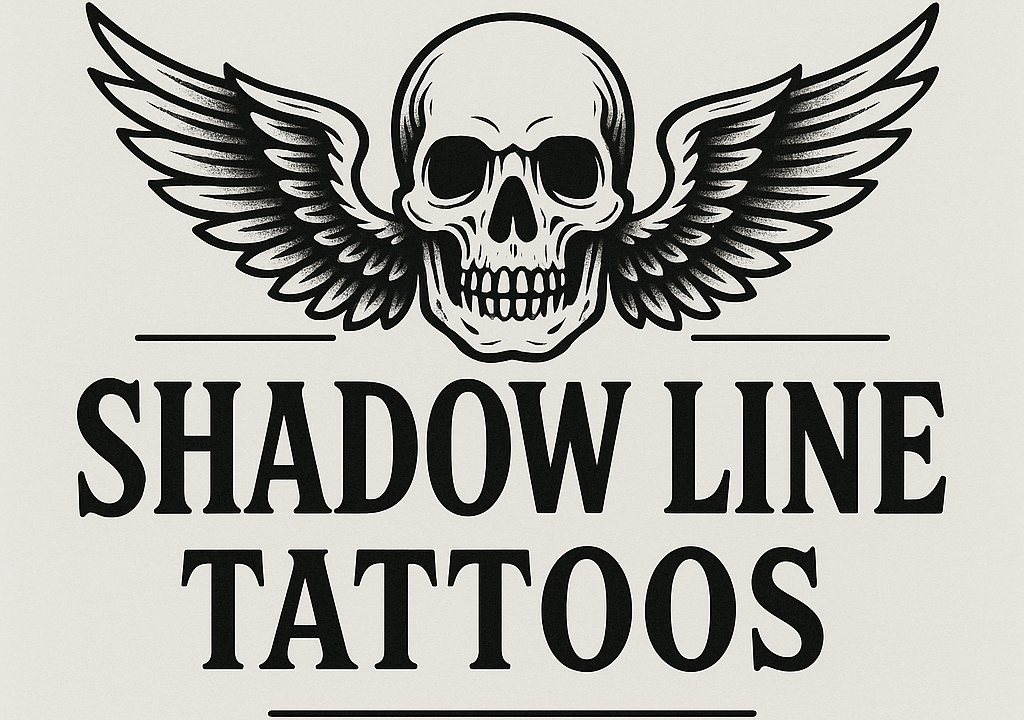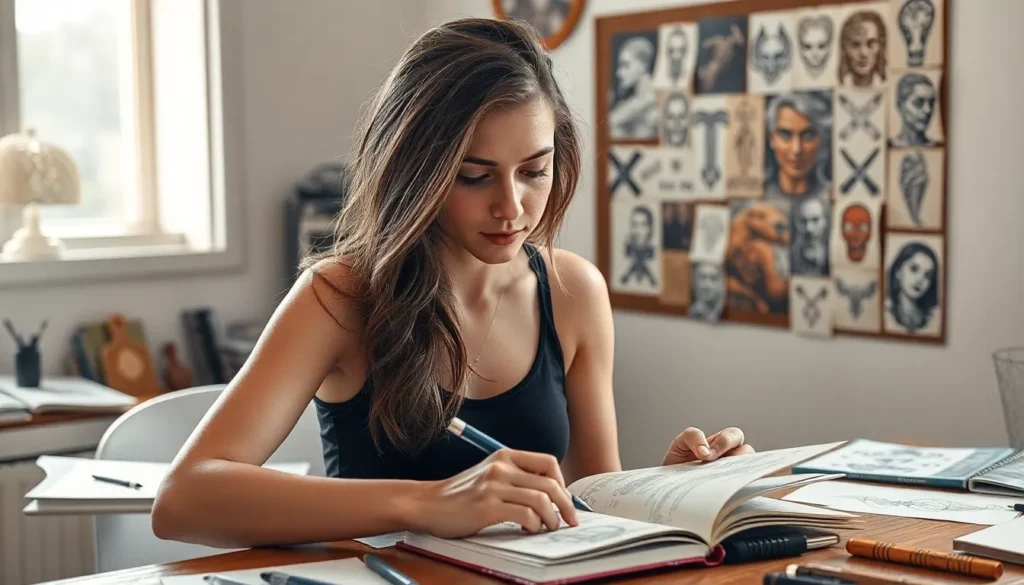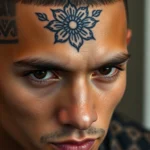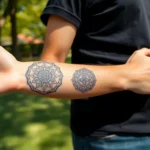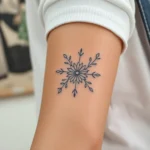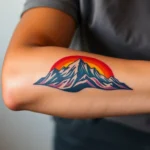Getting a tattoo is one of life’s most personal decisions but finding the perfect design can feel overwhelming. We’ve all been there – scrolling endlessly through Pinterest boards and Instagram feeds while that perfect piece of art remains frustratingly out of reach.
The good news? Generating meaningful tattoo ideas doesn’t have to be a shot in the dark. Whether you’re planning your first ink or adding to an existing collection there are proven strategies that’ll help you discover designs that truly resonate with your personality and story.
We’re about to share the exact methods professional tattoo artists and seasoned collectors use to brainstorm compelling concepts. From tapping into your personal experiences to exploring unexpected inspiration sources you’ll learn how to transform vague ideas into concrete designs that you’ll love for years to come.
Start With Your Personal Story and Experiences
Your own life holds the richest source of tattoo inspiration, containing countless moments and experiences that can translate into meaningful body art. We’ll explore how to tap into your personal narrative to create tattoo concepts that truly represent who you are.
Reflect on Life-Changing Moments
Identifying pivotal experiences becomes the foundation for deeply personal tattoo designs that carry lasting significance. We recommend creating a timeline of major life events such as graduations, marriages, career changes, or overcoming challenges. These moments often contain powerful symbols, dates, or imagery that translate beautifully into tattoo art.
Emotional turning points provide equally compelling inspiration for meaningful body art. Think about moments when you gained new perspectives, lost someone important, or achieved something you’d worked toward for years. Many people choose to honor these experiences with symbolic representations like phoenixes for rebirth, anchors for stability during storms, or exact flowers that bloomed during meaningful seasons.
Travel experiences and relocations frequently inspire location-based tattoo designs. Consider incorporating coordinates of places where important events occurred, silhouettes of city skylines where you found yourself, or cultural symbols from destinations that changed your worldview.
Document Your Hobbies and Passions
Current interests offer immediate inspiration for tattoo designs that reflect your personality and lifestyle. We suggest listing activities you spend most of your free time doing, whether that’s rock climbing, cooking, reading, gaming, or crafting. Each hobby contains visual elements that can be stylized into unique tattoo concepts.
Creative pursuits naturally lend themselves to artistic tattoo interpretations. Musicians might consider incorporating their favorite instruments, sheet music, or sound waves from meaningful songs. Artists could transform their preferred mediums like paintbrushes, color palettes, or abstract representations of their artistic style into body art.
Sports and fitness activities provide ever-changing imagery for tattoo inspiration. Athletes often choose equipment silhouettes, team logos, or motivational quotes that fuel their training. Adventure sports enthusiasts might select mountain ranges, wave patterns, or compass designs that represent their outdoor passions.
Collecting habits can reveal unexpected tattoo possibilities. Whether you collect vintage books, vinyl records, succulents, or antique cameras, these items often contain interesting shapes, textures, and symbolic meanings that transfer well to tattoo designs.
Consider Your Cultural Heritage
Family traditions offer rich inspiration for tattoo designs that honor your roots and ancestry. We encourage exploring symbols, patterns, or imagery from your cultural background, whether that includes Celtic knots, mandala designs, tribal patterns, or traditional folk art motifs. These elements can be incorporated into modern tattoo styles while maintaining their cultural significance.
Language elements from your heritage create meaningful tattoo options through scripts, calligraphy styles, or meaningful phrases. Consider words or phrases in your family’s native language, traditional writing systems, or quotes from cultural literature that resonate with your values.
Religious or spiritual symbols from your background provide deeply personal tattoo inspiration. These might include sacred geometry, religious iconography, spiritual animals, or meditation symbols that connect you to your cultural and spiritual identity.
Traditional celebrations and ceremonies from your culture contain visual elements perfect for tattoo adaptation. Festival imagery, ceremonial objects, traditional foods, or holiday symbols can be reimagined as unique body art that celebrates your heritage while reflecting your personal style.
Explore Visual Inspiration Sources Online

Now that we’ve explored personal sources of inspiration, let’s jump into the vast digital industry where countless tattoo ideas await discovery.
Browse Social Media Platforms Like Pinterest and Instagram
Pinterest serves as a goldmine for tattoo inspiration, offering endless visual content when you search for keywords like “tattoo ideas.” We can create boards dedicated to different styles, body placements, or themes that resonate with our personal story. Pinterest’s algorithm learns our preferences and suggests related designs, making it easier to discover variations we might not have considered.
Instagram transforms tattoo hunting into a curated experience by allowing us to follow exact tattoo artists and explore hashtags related to our interests. The platform’s algorithm creates a personalized feed of tattoo art based on our engagement patterns. We can save posts to collections, screenshot designs that catch our eye, and even reach out to artists directly through direct messaging.
Reddit communities provide authentic discussions about tattoo experiences and design ideas. Subreddits dedicated to tattoos offer real feedback from people who’ve actually gotten inked, helping us understand how certain designs age over time or look on different body types.
Visit Tattoo Artist Portfolios and Websites
Professional tattoo artists showcase their expertise through carefully curated online portfolios that demonstrate various styles and techniques. Websites like Industry Tattoo Gallery and Tattoodo feature extensive collections from artists worldwide, allowing us to explore different artistic approaches and cultural influences.
Artist portfolios reveal signature styles that can help us identify the perfect match for our vision. We can study how different artists interpret similar concepts, from traditional American designs to intricate geometric patterns. Many artists also share their creative process through blog posts or social media stories, giving us insight into how ideas transform into finished tattoos.
Local tattoo shop websites often feature before and after galleries that show how designs look on actual skin rather than just on paper. This realistic view helps us visualize how our chosen design might appear once completed.
Use Tattoo-Exact Apps and Generators
AI tattoo generators like BlackInk AI revolutionize the design process by creating unique tattoos based on text descriptions. We simply input our ideas, specify preferred styles and complexity levels, and receive customized designs within minutes. These tools allow us to experiment with different concepts without committing to expensive consultations.
Specialized tattoo apps offer features beyond basic image searches, including body placement simulators that show how designs look on different areas of our body. Some apps even provide size recommendations based on the chosen location and design complexity.
Digital design tools enable us to modify existing tattoo concepts by adjusting colors, adding personal elements, or combining multiple designs into one cohesive piece. We can create mood boards, sketch rough ideas, or even collaborate with artists remotely before our actual appointment.
Draw From Art and Design Elements
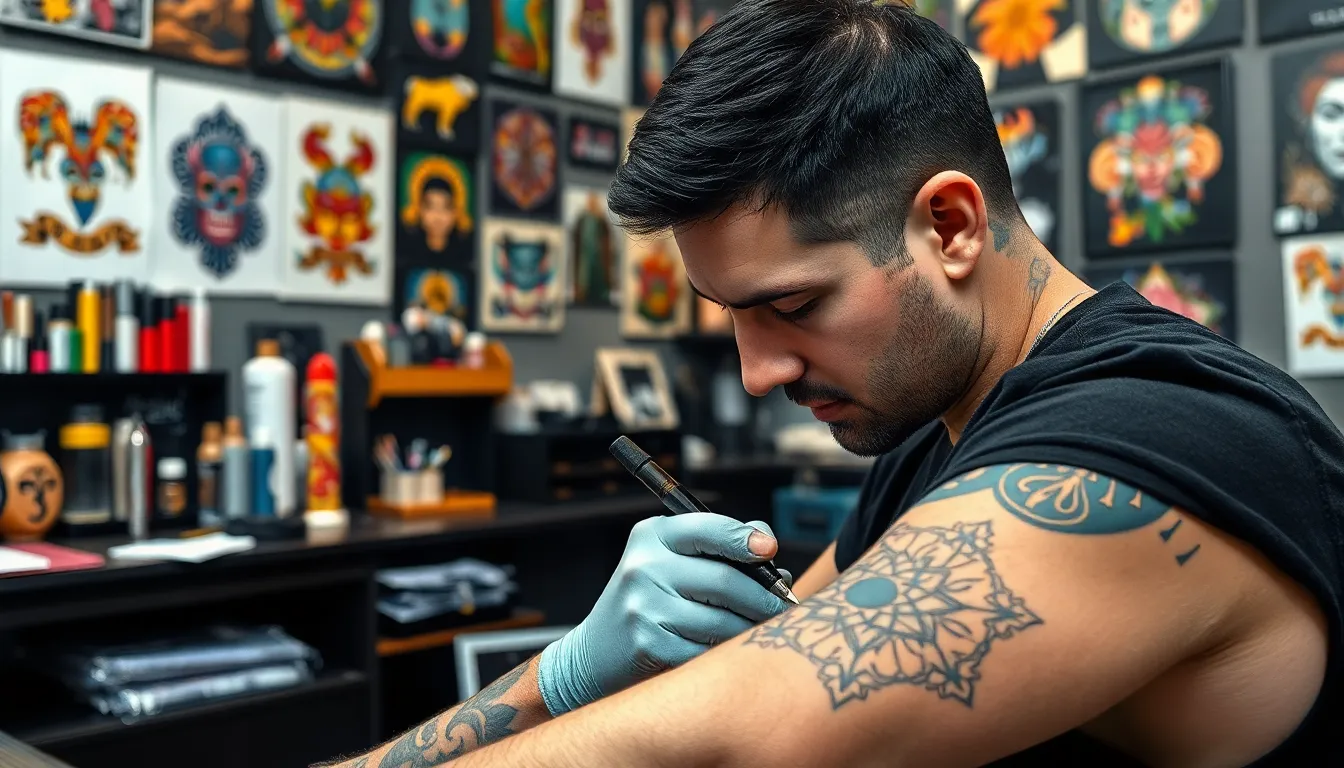
Art history and design principles offer endless possibilities for creating distinctive tattoo concepts. We can transform centuries of artistic innovation into personalized body art that reflects our aesthetic preferences.
Study Different Art Movements and Styles
Traditional tattoo styles provide timeless foundations for our designs, featuring classic motifs like skulls and maritime symbols that’ve remained popular for decades. American traditional, Japanese traditional, and neo-traditional styles each offer distinct color palettes and linework techniques we can adapt to our personal vision.
Cultural art forms from around the industry serve as rich inspiration sources for meaningful tattoos. Tribal designs from Maori culture, specifically kirituhi adaptations created for non-Maori individuals, showcase intricate patterns that tell stories through geometric forms and flowing lines.
Art nouveau movements bring organic curves and botanical elements into tattoo design, while art deco styles contribute bold geometric shapes and symmetrical patterns. We can study these historical movements to understand how artists used composition, balance, and symbolism to create impactful visual statements.
Incorporate Geometric Patterns and Mandala Designs
Geometric tattoos use simple shapes like triangles, circles, and lines to create elegant designs that symbolize personal themes without requiring complex artistic skills. These mathematical patterns often represent balance, harmony, and the interconnectedness of life elements.
Mandala designs offer visually appealing options that combine spiritual symbolism with intricate geometric patterns. Sacred geometry principles found in mandalas create mesmerizing focal points that work beautifully as standalone pieces or integrated elements within larger compositions.
Abstract patterns allow us to express creativity through non-representational forms that hold personal meaning. We can combine various geometric elements to create unique compositions that reflect our individual aesthetic while maintaining visual coherence through repetition and symmetry.
Explore Typography and Lettering Styles
Typography selection requires careful consideration of font styles and readability, especially since ink naturally spreads over time and can affect letter clarity. We should choose fonts that maintain their legibility even as the tattoo ages, avoiding overly thin or decorative scripts for smaller text applications.
Lettering integration works best when we incorporate meaningful words or phrases that complement our overall design aesthetic. Inspiring letterforms found in art books, calligraphy samples, or social media platforms can serve as starting points for custom lettering that matches our tattoo’s style and tone.
Script variations range from bold block letters to delicate cursive styles, each carrying different emotional weight and visual impact. We can experiment with different lettering approaches to find the perfect balance between readability and artistic expression for our chosen words or phrases.
Connect With Nature and Natural Symbols
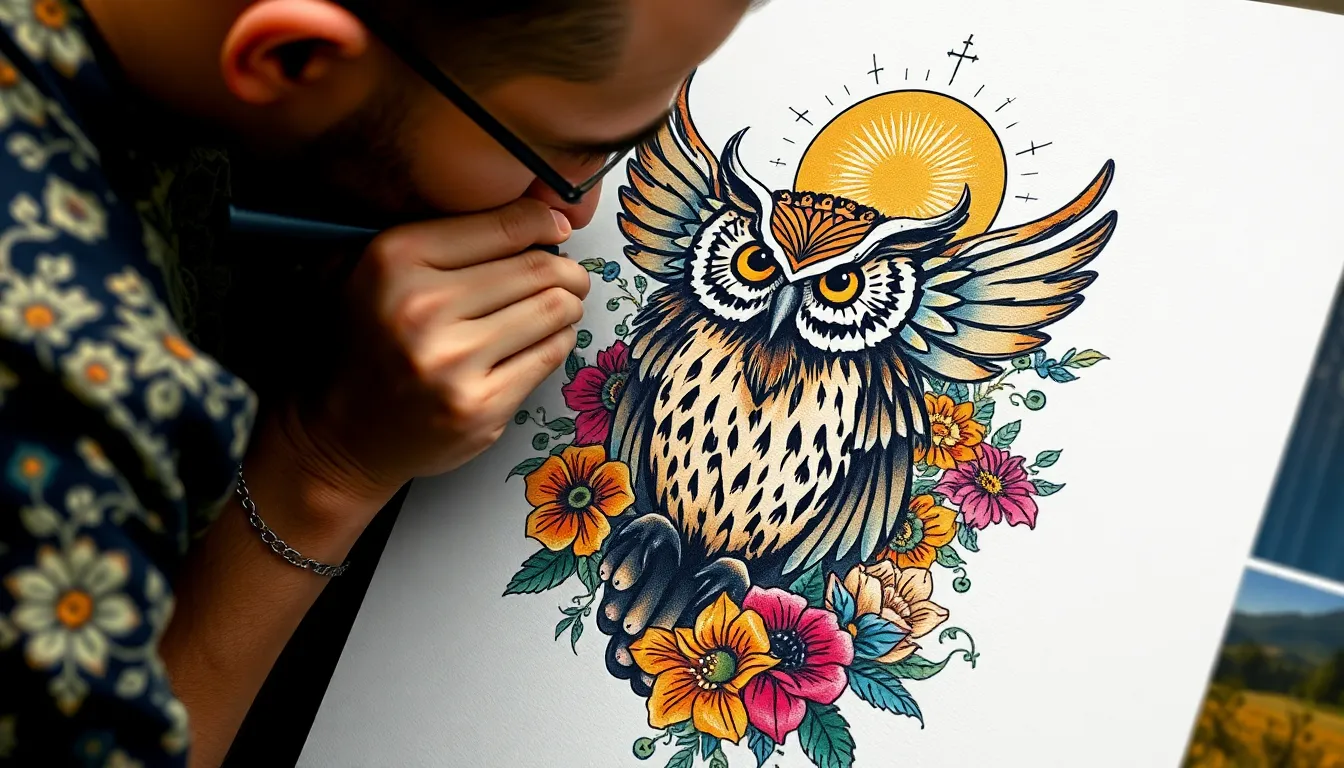
Drawing inspiration from the natural industry opens up endless possibilities for meaningful tattoo designs. Nature provides symbolic elements that resonate across cultures and personal experiences.
Research Animal Symbolism and Meanings
Animals carry profound symbolic meanings that can transform your tattoo from simple imagery into powerful personal statements. Birds represent freedom and spiritual transcendence, making them perfect choices for those celebrating new beginnings or personal liberation. Snakes symbolize transformation and rebirth, ideal for marking important life changes or personal growth journeys.
Cultural significance adds depth to animal-based tattoo designs beyond surface-level aesthetics. Lions embody courage and leadership in many traditions, while elephants represent wisdom and memory in various cultures. Wolves signify loyalty and family bonds, making them meaningful choices for commemorating relationships or personal values.
Consider your personal connection to exact animals when exploring symbolic meanings. Research the cultural contexts surrounding your chosen animal totem to ensure the symbolism aligns with your intended message and respects traditional interpretations.
Consider Botanical Elements Like Flowers and Trees
Flowers offer diverse symbolic meanings that can perfectly capture your personal story or emotional journey. Roses traditionally symbolize love and passion, while sunflowers represent loyalty and devotion to important relationships. Cherry blossoms embody the beauty of life’s fleeting moments, making them ideal for honoring temporary but precious experiences.
Trees symbolize strength and longevity in tattoo designs, representing personal growth and life’s enduring connections. Oak trees signify stability and endurance, perfect for marking personal resilience or family heritage. Willow trees represent flexibility and grace through adversity, while pine trees embody eternal life and steadfast determination.
Botanical elements create versatile design options that work beautifully alone or combined with other symbolic elements. Leaves can represent seasonal changes or personal transformations, while branches might symbolize family connections or life’s branching paths.
Incorporate Celestial Bodies and Natural Phenomena
Stars and planets add mystical elements to tattoo designs while carrying deep symbolic significance. Stars often symbolize guidance and navigation through life’s challenges, making them meaningful choices for those seeking direction or honoring mentors. Planets can represent different life aspects, with the moon symbolizing intuition and cycles, while the sun embodies energy and new beginnings.
Natural phenomena create visually striking designs that capture powerful moments or emotions in permanent art. Lightning bolts represent sudden inspiration or life-changing realizations, while rainbows symbolize hope after difficult periods. Sunsets can commemorate endings that lead to new beginnings, and storm clouds might represent overcoming personal challenges.
Celestial designs work exceptionally well when combined with other natural elements to create comprehensive symbolic narratives. Consider pairing stars with animal totems or incorporating moon phases with botanical elements to create unique, personalized designs that tell your complete story.
Investigate Cultural and Mythological References
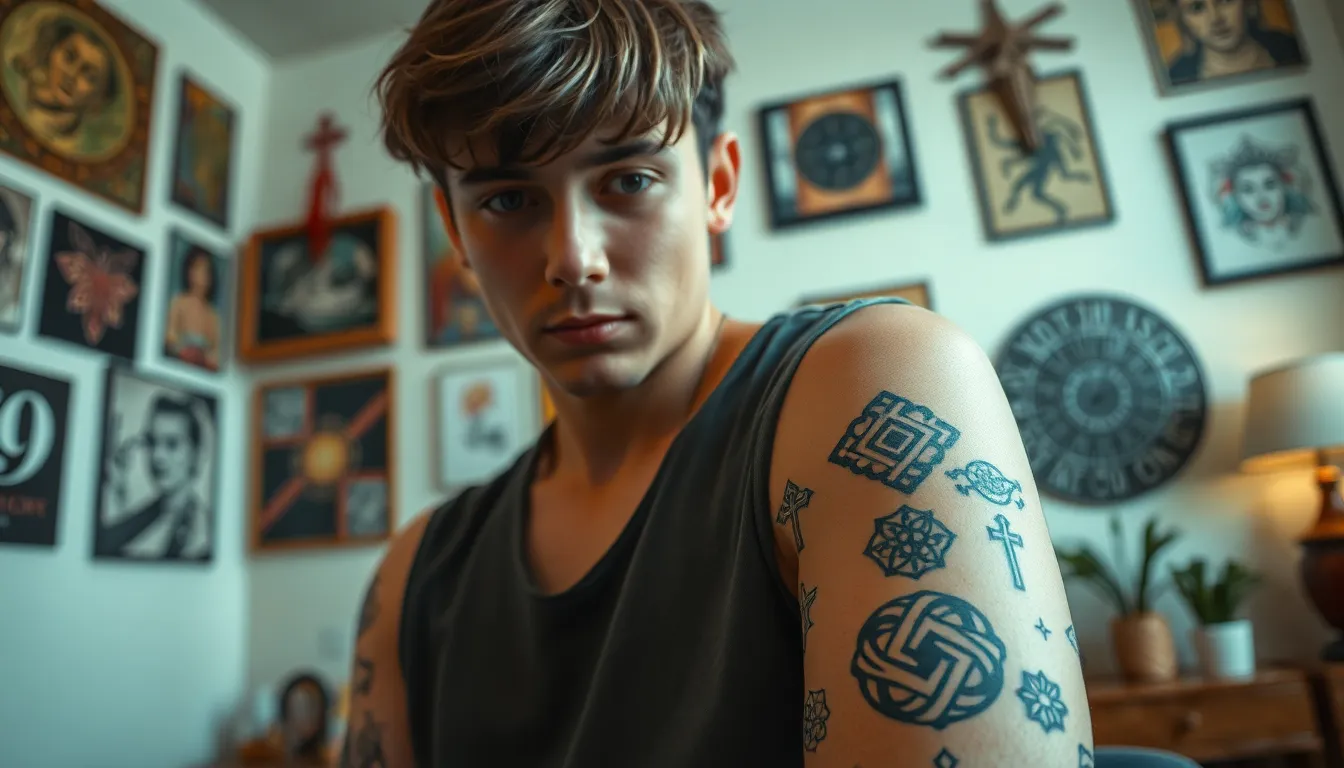
Cultural and mythological elements offer some of the richest sources for tattoo inspiration, connecting us to thousands of years of human storytelling and symbolism. These references can transform a simple design into a powerful statement that carries deep meaning across cultures and generations.
Explore Ancient Symbols and Their Significance
Ancient symbols provide timeless tattoo inspiration that has resonated with humanity for millennia. The Ankh from Egyptian culture symbolizes life and vitality, making it perfect for those celebrating new beginnings or personal transformation. Om from Hindu tradition represents the universe and spirituality, offering a powerful choice for individuals seeking deeper meaning in their body art.
Celtic knotwork creates intricate patterns that symbolize eternal connections and the cyclical nature of life. The Ouroboros from Greek mythology depicts a serpent eating its own tail, signifying renewal and the endless cycle of death and rebirth. These symbols work particularly well when we want our tattoos to carry philosophical weight beyond their visual appeal.
Maori ta moko patterns traditionally represent identity, status, and spiritual beliefs within Polynesian culture. Japanese kamon symbols served as family crests and can be adapted to represent personal or family heritage. When choosing these ancient symbols, we should research their original meanings to ensure our tattoos honor their cultural significance appropriately.
Research Mythology From Different Cultures
Mythological creatures and deities offer endless possibilities for dramatic and meaningful tattoo designs. Greek mythology provides compelling characters like Zeus representing power and authority, Athena symbolizing wisdom and warfare, or Medusa embodying transformation and protection. These figures translate beautifully into both realistic and stylized tattoo interpretations.
Norse mythology brings us powerful gods like Odin representing wisdom and magic, Thor symbolizing strength and protection, or creatures like Fenrir the wolf representing primal power. These mythological elements work exceptionally well for larger tattoo pieces that tell complete stories across multiple sessions.
Asian mythology offers diverse inspirations including the Dragon King symbolizing power over water and weather, the Eight Trigrams representing universal balance, or the Phoenix signifying rebirth and renewal. Dragons in Asian culture particularly differ from Western interpretations, representing good fortune and wisdom rather than destruction.
African tribal patterns and Native American designs carry profound cultural meanings that require careful consideration and respect. We should approach these with proper understanding of their cultural significance and avoid appropriation by ensuring our designs honor rather than exploit these traditions.
Consider Religious or Spiritual Iconography
Religious and spiritual symbols can create deeply personal tattoos that reflect our beliefs and spiritual journey. Christian symbols like the cross represent faith and sacrifice, while the dove symbolizes peace and the Holy Spirit. The fish symbol or ichthys carries historical significance as an early Christian identifier.
Buddhist iconography offers the Wheel of Dharma representing the path to enlightenment, and the lotus flower symbolizing spiritual growth rising from difficult circumstances. The Buddha himself can represent inner peace and mindfulness when depicted respectfully.
Hindu symbols include Ganesha representing the removal of obstacles and new beginnings, while the Om symbol connects us to universal consciousness. These symbols often incorporate intricate geometric patterns that create visually stunning tattoo compositions.
Islamic geometric patterns create beautiful, complex designs that avoid figurative representations while maintaining deep spiritual significance. Jewish symbols like the Star of David or Hebrew text can connect us to cultural and religious heritage when chosen thoughtfully.
When incorporating religious iconography, we must ensure our designs reflect genuine respect for the beliefs they represent rather than treating them as mere aesthetic choices.
Collaborate With Professional Tattoo Artists
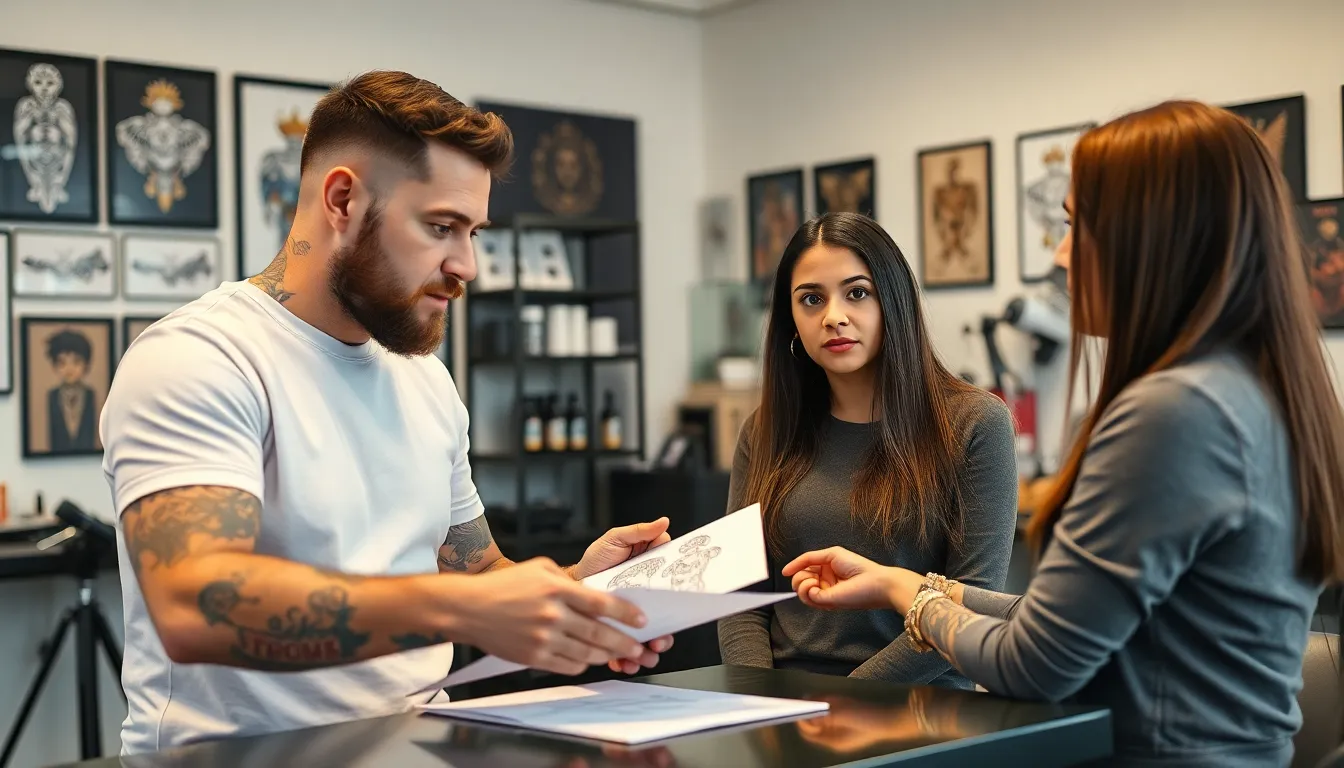
Working with skilled tattoo artists transforms your raw inspiration into expertly crafted designs. Professional collaboration ensures your tattoo concept becomes both technically sound and artistically compelling.
Schedule Consultation Sessions for Custom Designs
Consultation sessions typically last 15-30 minutes and serve as the foundation for your custom tattoo project. We recommend booking these initial meetings to discuss your ideas thoroughly and establish clear communication with your chosen artist.
During these sessions, artists evaluate the feasibility of your concept and provide technical insights about placement, sizing, and design modifications. Most tattoo shops offer consultations as separate appointments, allowing both you and the artist dedicated time to explore your vision without the pressure of immediate tattooing.
Professional consultation sessions help establish realistic timelines for complex designs that may require multiple sessions. Artists use this time to explain their process, discuss aftercare requirements, and address any concerns you might have about the tattooing experience.
Discuss Your Vision and Get Expert Input
Sharing your personal experiences and inspirations creates the groundwork for meaningful tattoo designs. We encourage you to openly communicate the story behind your desired tattoo, including emotional significance and symbolic elements that matter to you.
Artists refine your initial concepts by suggesting design modifications that enhance visual impact while maintaining your intended meaning. Their experience helps identify potential issues with aging, placement challenges, or technical limitations that might affect your tattoo’s longevity.
Professional input often reveals creative possibilities you hadn’t considered, expanding your original vision into something more sophisticated. Artists can suggest complementary elements, color schemes, or stylistic approaches that elevate your basic concept into a cohesive artistic statement.
Brainstorming sessions with your artist generate fresh perspectives on familiar themes and help you explore different interpretations of your core idea. This collaborative approach ensures your final design reflects both your personal vision and professional expertise.
Review Artist Portfolios for Style Compatibility
Portfolio reviews reveal whether an artist’s aesthetic aligns with your tattoo vision and preferred style. We suggest examining multiple portfolios to identify artists whose work resonates with your design goals and technical requirements.
Look for consistency in line work, color application, and overall composition quality throughout each artist’s portfolio. Artists often specialize in exact styles like traditional, realism, or geometric patterns, so matching their expertise to your concept ensures optimal results.
Check for experience with themes, colors, and placement locations relevant to your tattoo idea. Artists who regularly work with your preferred elements demonstrate familiarity with technical challenges and creative answers exact to your design type.
Portfolio diversity indicates an artist’s versatility, while specialized collections show deep expertise in particular styles or subject matter. Consider both factors when selecting an artist whose skills complement your tattoo concept and personal aesthetic preferences.
Keep a Tattoo Idea Journal or Mood Board
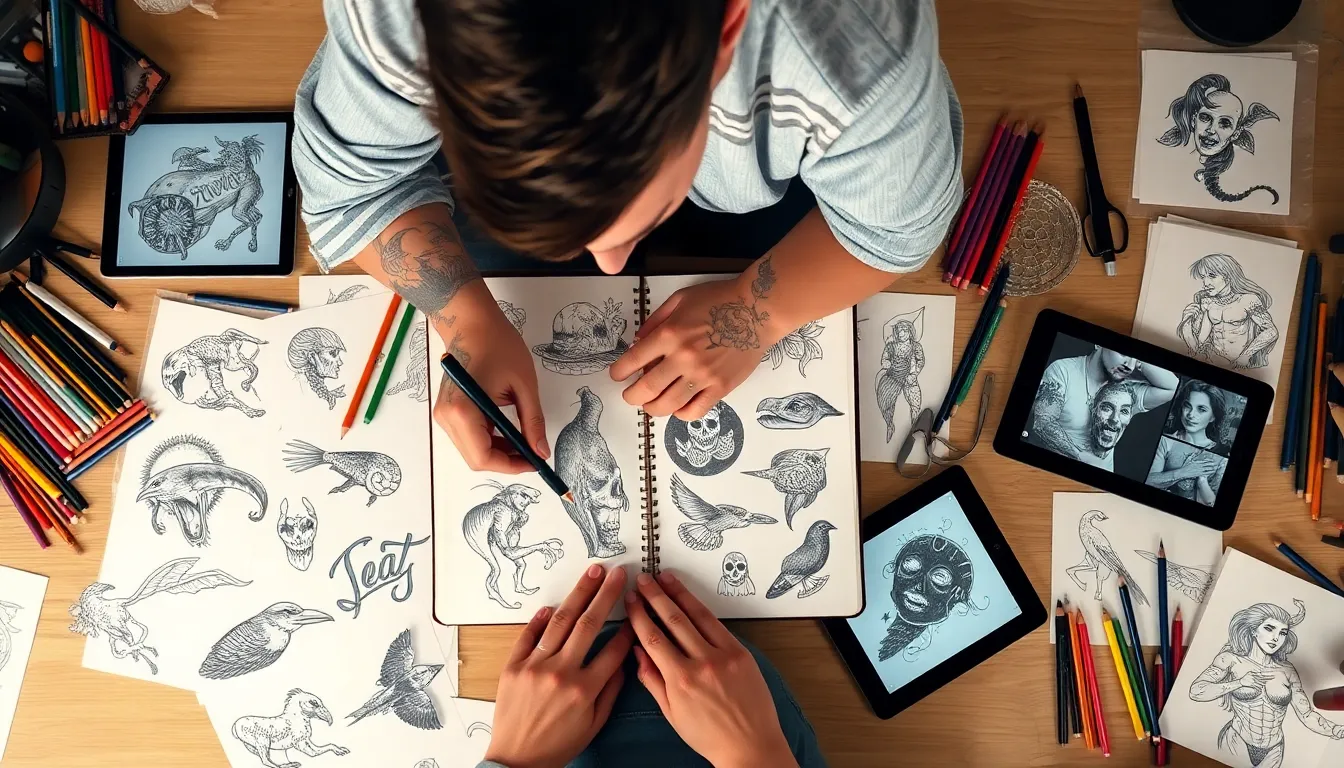
Building on your collaborative work with professional artists, maintaining a dedicated space for capturing inspiration becomes essential for developing meaningful tattoo concepts. Documenting your ideas systematically helps you refine concepts that truly resonate with your personal story.
Document Inspiration as It Strikes
Creating a tattoo idea journal or digital mood board captures fleeting inspiration before it disappears. We recommend keeping both physical and digital options available since inspiration strikes at unexpected moments throughout our daily lives.
Physical journals work exceptionally well for sketching quick concepts during conversations or while exploring new environments. Carry a small notebook specifically dedicated to tattoo ideas and use it to jot down symbols, phrases, or imagery that resonates with your personal narrative.
Digital mood boards offer superior organization capabilities through platforms like Pinterest, Milanote, or even simple photo albums on your phone. Social media platforms provide rich sources of inspiration from nature, art movements, and cultural symbols that can spark unique design concepts.
Save screenshots of meaningful imagery immediately when you encounter them online. Document the context surrounding each piece of inspiration by adding brief notes about why it appeals to you or how it connects to your personal experiences.
Create Visual Collections of Related Themes
Organizing inspiration into themed collections reveals patterns in your preferences and helps identify cohesive design directions. Group similar concepts together based on style preferences like realism, traditional, or geometric patterns.
Thematic collections might focus on exact subjects such as botanical elements, celestial bodies, or cultural symbols from your heritage. Visual groupings help you spot recurring motifs that consistently appear in your inspiration, indicating strong personal connections to certain imagery.
Create separate boards or journal sections for different tattoo placement ideas since arm pieces require different design considerations than back or leg tattoos. Reference photos become particularly valuable for realistic designs, with websites like Unsplash providing high-quality images for visual reference.
Color palette collections help establish mood and aesthetic preferences for future consultations with tattoo artists. Gather images that showcase color combinations or black and gray techniques that appeal to your personal taste.
Track the Evolution of Your Ideas Over Time
Monitoring how your tattoo concepts develop reveals genuine long-term interests versus temporary fascinations. Date each entry in your journal or mood board collection to observe how themes evolve and which concepts maintain their appeal over months or years.
Regular review sessions help identify ideas that consistently resurface in your inspiration gathering process. Concepts that repeatedly appear across different contexts often indicate deeply meaningful connections worth exploring further with professional artists.
Evolution tracking also prevents impulsive decisions by creating a cooling-off period for new inspirations. Ideas that seemed perfect initially might lose their appeal after several weeks, while others gain significance through repeated consideration.
Document modifications to existing concepts as they develop sophistication through your research process. Note how cultural research, artistic exploration, or personal experiences influence your original ideas and push them toward more refined expressions of your intended meaning.
Consider Placement and Size Requirements
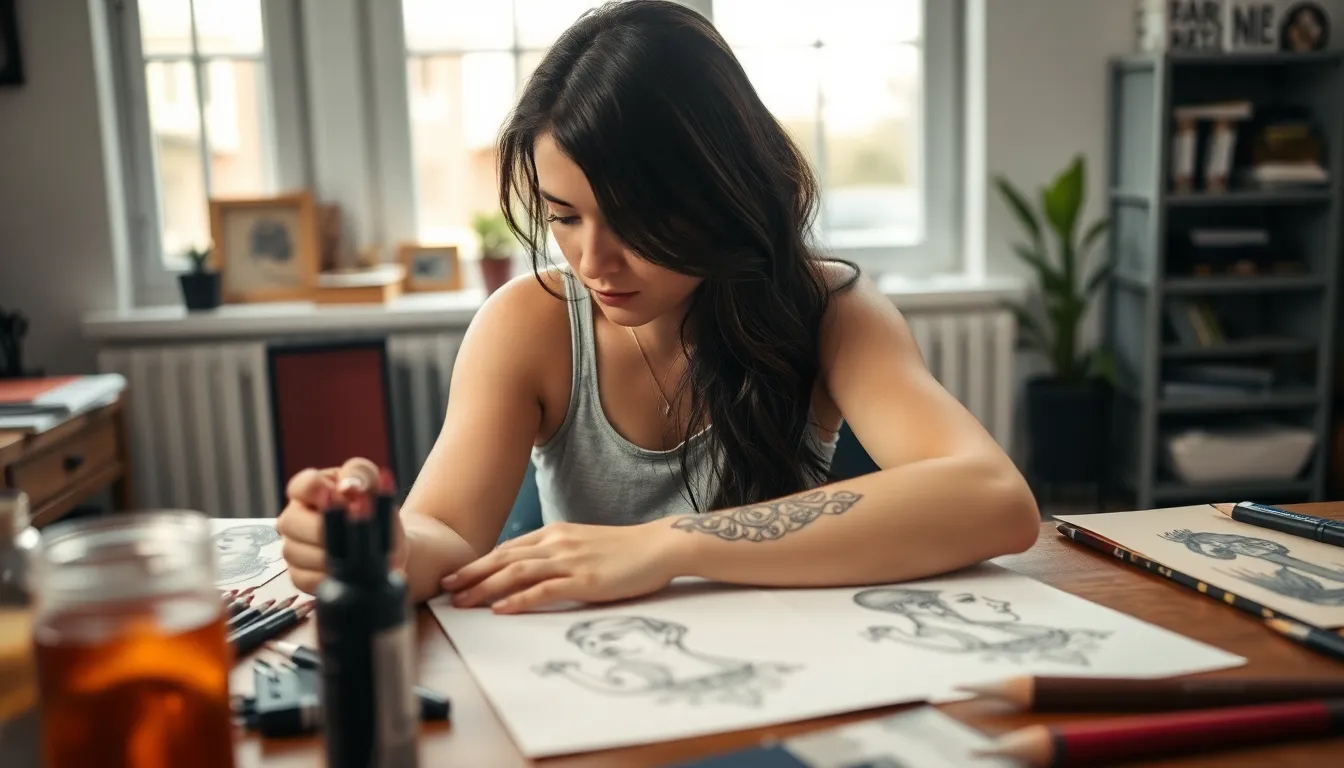
Once you’ve refined your tattoo concept through journaling and mood boarding, the physical aspects of your design become crucial considerations. Strategic placement decisions can dramatically impact both the visual impact and practical experience of your new tattoo.
Think About Body Placement and Visibility
Professional environments often dictate tattoo visibility requirements, making strategic placement essential for career considerations. Areas like forearms, hands, and neck remain highly visible in most workplace settings, while upper arms, back, and torso locations offer more discretion when needed.
Daily activities influence how your tattoo will be seen and experienced throughout different seasons. Shoulder and upper back tattoos stay hidden under most clothing, while ankle and wrist placements become more visible during warmer months when you wear shorts and short sleeves.
Body contours affect how your design will look over time as your body changes. Curved areas like shoulders and ribs can enhance flowing designs, while flat surfaces like the back provide ideal canvases for detailed artwork that won’t distort with movement.
Size compatibility with your chosen body area determines the level of detail possible in your design. Smaller areas like wrists and fingers require simplified designs, while larger spaces like the back or thigh accommodate intricate artwork with multiple elements.
Factor in Pain Tolerance and Healing Considerations
Nerve density varies significantly across different body areas, directly impacting the tattooing experience. Areas with thin skin over bone, such as ribs, spine, and ankles, typically cause more discomfort than fleshy areas like upper arms and thighs.
Healing timeframes differ based on placement location and your body’s natural healing processes. Tattoos on areas that flex frequently, like hands and feet, require longer healing periods and may need touch-ups more often than stable areas.
Aftercare accessibility becomes crucial for proper healing, especially in hard-to-reach locations. Back tattoos require assistance with cleaning and moisturizing, while arm and leg placements allow for independent care throughout the healing process.
Clothing considerations during healing affect your daily routine for 2-4 weeks after getting tattooed. Tight clothing can irritate fresh tattoos, making loose-fitting garments essential for areas like waistlines and bra lines.
Plan for Future Tattoo Additions and Flow
Cohesive design planning ensures your current tattoo complements potential future additions rather than limiting your options. Leave adequate spacing around your design to accommodate connecting elements or complementary pieces that might develop over time.
Style consistency across multiple tattoos creates visual harmony on your body canvas. Mixing drastically different styles like photorealistic portraits with traditional American designs can create visual conflicts that detract from each piece’s individual impact.
Flow patterns follow your body’s natural lines and curves to create seamless transitions between tattoos. Designs that work with muscle definition and bone structure appear more integrated and aesthetically pleasing than those that fight against your body’s natural form.
Future expansion possibilities should influence your initial size and placement decisions. Starting with a smaller central piece allows for organic growth into larger compositions, while beginning with a massive design limits your ability to add complementary elements later.
Conclusion
We’ve explored many pathways to discover your perfect tattoo design—from mining your personal experiences and cultural heritage to leveraging digital resources and collaborating with skilled artists. The key lies in combining multiple inspiration sources to create something uniquely yours.
Remember that the best tattoos tell your story while reflecting your personality and values. Whether you’re drawn to nature’s symbolism mythological references or geometric patterns take time to document your ideas and let them evolve naturally.
Your tattoo journey doesn’t have to feel overwhelming. By following these strategies and working with the right artist you’ll transform those initial sparks of inspiration into meaningful body art that you’ll treasure for years to come.
Frequently Asked Questions
What are the best sources of inspiration for meaningful tattoo designs?
The most meaningful tattoo inspiration comes from your personal experiences, including pivotal life moments, travel memories, hobbies, and cultural heritage. Create a timeline of significant events and consider symbols that represent these experiences. Your family traditions, spiritual beliefs, and personal interests often provide the richest sources for tattoo concepts that truly reflect your story.
How can I use social media platforms to find tattoo ideas?
Pinterest and Instagram are excellent resources for discovering tattoo designs. Create themed boards, follow professional tattoo artists, and save designs that resonate with you. Reddit communities offer authentic discussions and feedback. Use hashtags to explore specific styles and engage with tattoo communities to gather insights and inspiration from other enthusiasts.
Should I consider cultural and mythological symbols for my tattoo?
Cultural and mythological symbols can create powerful tattoo designs, but approach them with respect and understanding. Research the meanings behind ancient symbols like the Ankh or Om, and mythological creatures from various cultures. Ensure you genuinely connect with the symbol’s significance rather than choosing it purely for aesthetic reasons, especially with sacred or culturally specific imagery.
How important is it to work with a professional tattoo artist during the design process?
Working with a professional artist is crucial for transforming your ideas into a technically sound design. Schedule consultation sessions to discuss feasibility, placement, and sizing. Artists provide valuable insights on how designs age, what works best for different body areas, and can enhance your concept while maintaining its meaning. Review portfolios to ensure style compatibility.
What should I consider when choosing tattoo placement and size?
Consider visibility in professional environments, daily activities that might affect the tattoo, and pain tolerance for different body areas. Think about future tattoo additions and how designs will flow together. Strategic placement ensures your tattoo ages well and complements your lifestyle. Different body areas have varying healing times and discomfort levels to factor into your decision.
How can I organize and track my tattoo ideas effectively?
Keep a tattoo idea journal or digital mood board to systematically capture inspiration. Document ideas as they arise, create visual collections of related themes, and track how your concepts evolve over time. This helps distinguish genuine interests from fleeting fascinations and ensures your final tattoo choice is well-considered and meaningful to your personal story.
